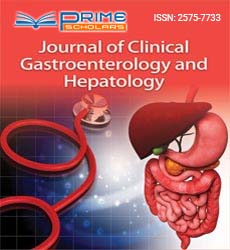Commentary - (2023) Volume 7, Issue 6
Understanding Gastric Ulcers: Causes, Symptoms, and Treatment
Guo Wu*
Department of Gastroenterology, Osaka University, Japan
*Correspondence:
Guo Wu,
Department of Gastroenterology, Osaka University,
Japan,
Email:
Received: 29-Nov-2023, Manuscript No. IPJCGH-24-18976;
Editor assigned: 01-Dec-2023, Pre QC No. IPJCGH-24-18976 (PQ);
Reviewed: 15-Dec-2023, QC No. IPJCGH-24-18976;
Revised: 20-Dec-2023, Manuscript No. IPJCGH-24-18976 (R);
Published:
27-Dec-2023, DOI: 10.36648/2575-7733.7.6.55
Description
Gastric ulcers, also known as stomach ulcers, are a common
yet painful gastrointestinal condition that affects millions of
people worldwide. These ulcers are open sores that develop
on the inner lining of the stomach, causing discomfort and
potential complications if left untreated. In this article, we
will explore the causes, symptoms, and treatment options
for gastric ulcers. Gastric ulcers are primarily caused by the
imbalance between the stomach’s protective mechanisms and
the factors that can damage its lining. The leading cause of
gastric ulcers is the infection with Helicobacter pylori bacteria.
This bacterium weakens the stomach’s protective mucous
layer, allowing stomach acid to erode the lining and form
ulcers. Other contributing factors include the prolonged use
of nonsteroidal anti-inflammatory drugs such as aspirin and
ibuprofen. These medications can irritate the stomach lining
and increase the risk of developing ulcers. Smoking, excessive
alcohol consumption, and stress are also known to exacerbate
gastric ulcer formation. Gastric ulcers often present with a
range of symptoms, and the severity may vary from person
to person. Common signs of gastric ulcers include. Persistent,
burning pain in the abdomen, particularly between meals and
in the early hours of the morning. Some individuals with gastric
ulcers may experience nausea and vomiting, which can further
aggravate the condition. Due to the discomfort associated with
gastric ulcers, individuals may lose interest in eating, leading to
unintended weight loss. Excessive gas production and bloating
may occur as a result of impaired digestion and increased
acidity. Gastrointestinal bleeding caused by ulcers can result
in the passage of dark, tarry stools, indicating the presence
of blood. The treatment of gastric ulcers typically involves a
combination of medications and lifestyle changes. Here are
the primary approaches a course of antibiotics is prescribed
to eradicate the bacteria and promote ulcer healing. These
medications help reduce stomach acid production, providing
relief and allowing the ulcers to heal. Common PPIs include
omeprazole, lansoprazole, and esomeprazole. Medications
like ranitidine and famotidine can also decrease stomach acid
production and promote healing. Over-the-counter antacids
can offer short-term relief by neutralizing stomach acid, but
they do not promote long-term healing. Individuals with gastric
ulcers should avoid NSAIDs, smoking, and excessive alcohol
intake, as these can exacerbate the condition. Incorporating
stress-reducing activities, such as exercise, meditation, and
relaxation techniques, can be beneficial in managing gastric
ulcers. Gastric ulcers are a prevalent gastrointestinal issue
that can significantly impact an individual’s quality of life.
Understanding the causes, recognizing symptoms, and seeking
timely medical intervention are crucial for effective management
and prevention of complications. While medications play a vital
role in treatment, lifestyle modifications are equally important
in achieving long-term relief from gastric ulcers. If you suspect
you have gastric ulcers or are experiencing persistent abdominal
pain, it is essential to consult a healthcare professional for a
proper diagnosis and tailored treatment plan. In some cases,
ulcers can penetrate the stomach wall, causing a perforation.
This can result in the leakage of stomach contents into the
abdominal cavity, leading to a life-threatening condition that
requires urgent surgical intervention.
Acknowledgement
None.
Conflict Of Interest
The authors declare that they have no conflict of interest.
Citation: Wu G (2023) Understanding Gastric Ulcers: Causes, Symptoms, and Treatment. J Clin Gastroenterol Hepatol. 7:55.
Copyright: © 2023 Wu G. This is an open-access article distributed under the terms of the Creative Commons Attribution License,
which permits unrestricted use, distribution, and reproduction in any medium, provided the original author and source
are credited.

